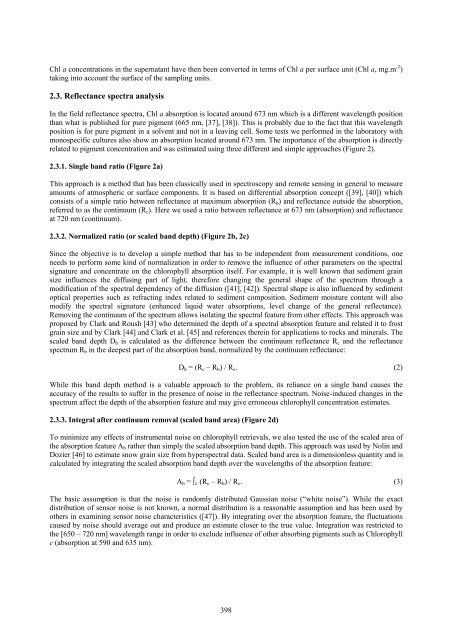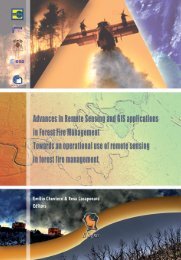Mapping microphytobenthos in the intertidal zone of Northern ...
Mapping microphytobenthos in the intertidal zone of Northern ...
Mapping microphytobenthos in the intertidal zone of Northern ...
You also want an ePaper? Increase the reach of your titles
YUMPU automatically turns print PDFs into web optimized ePapers that Google loves.
Chl a concentrations <strong>in</strong> <strong>the</strong> supernatant have <strong>the</strong>n been converted <strong>in</strong> terms <strong>of</strong> Chl a per surface unit (Chl a, mg.m -2 )<br />
tak<strong>in</strong>g <strong>in</strong>to account <strong>the</strong> surface <strong>of</strong> <strong>the</strong> sampl<strong>in</strong>g units.<br />
2.3. Reflectance spectra analysis<br />
In <strong>the</strong> field reflectance spectra, Chl a absorption is located around 673 nm which is a different wavelength position<br />
than what is published for pure pigment (665 nm, [37], [38]). This is probably due to <strong>the</strong> fact that this wavelength<br />
position is for pure pigment <strong>in</strong> a solvent and not <strong>in</strong> a leav<strong>in</strong>g cell. Some tests we performed <strong>in</strong> <strong>the</strong> laboratory with<br />
monospecific cultures also show an absorption located around 673 nm. The importance <strong>of</strong> <strong>the</strong> absorption is directly<br />
related to pigment concentration and was estimated us<strong>in</strong>g three different and simple approaches (Figure 2).<br />
2.3.1. S<strong>in</strong>gle band ratio (Figure 2a)<br />
This approach is a method that has been classically used <strong>in</strong> spectroscopy and remote sens<strong>in</strong>g <strong>in</strong> general to measure<br />
amounts <strong>of</strong> atmospheric or surface components. It is based on differential absorption concept ([39], [40]) which<br />
consists <strong>of</strong> a simple ratio between reflectance at maximum absorption (Rb) and reflectance outside <strong>the</strong> absorption,<br />
referred to as <strong>the</strong> cont<strong>in</strong>uum (Rc). Here we used a ratio between reflectance at 673 nm (absorption) and reflectance<br />
at 720 nm (cont<strong>in</strong>uum).<br />
2.3.2. Normalized ratio (or scaled band depth) (Figure 2b, 2c)<br />
S<strong>in</strong>ce <strong>the</strong> objective is to develop a simple method that has to be <strong>in</strong>dependent from measurement conditions, one<br />
needs to perform some k<strong>in</strong>d <strong>of</strong> normalization <strong>in</strong> order to remove <strong>the</strong> <strong>in</strong>fluence <strong>of</strong> o<strong>the</strong>r parameters on <strong>the</strong> spectral<br />
signature and concentrate on <strong>the</strong> chlorophyll absorption itself. For example, it is well known that sediment gra<strong>in</strong><br />
size <strong>in</strong>fluences <strong>the</strong> diffus<strong>in</strong>g part <strong>of</strong> light, <strong>the</strong>refore chang<strong>in</strong>g <strong>the</strong> general shape <strong>of</strong> <strong>the</strong> spectrum through a<br />
modification <strong>of</strong> <strong>the</strong> spectral dependency <strong>of</strong> <strong>the</strong> diffusion ([41], [42]). Spectral shape is also <strong>in</strong>fluenced by sediment<br />
optical properties such as refract<strong>in</strong>g <strong>in</strong>dex related to sediment composition. Sediment moisture content will also<br />
modify <strong>the</strong> spectral signature (enhanced liquid water absorptions, level change <strong>of</strong> <strong>the</strong> general reflectance).<br />
Remov<strong>in</strong>g <strong>the</strong> cont<strong>in</strong>uum <strong>of</strong> <strong>the</strong> spectrum allows isolat<strong>in</strong>g <strong>the</strong> spectral feature from o<strong>the</strong>r effects. This approach was<br />
proposed by Clark and Roush [43] who determ<strong>in</strong>ed <strong>the</strong> depth <strong>of</strong> a spectral absorption feature and related it to frost<br />
gra<strong>in</strong> size and by Clark [44] and Clark et al. [45] and references <strong>the</strong>re<strong>in</strong> for applications to rocks and m<strong>in</strong>erals. The<br />
scaled band depth Db is calculated as <strong>the</strong> difference between <strong>the</strong> cont<strong>in</strong>uum reflectance Rc and <strong>the</strong> reflectance<br />
spectrum Rb <strong>in</strong> <strong>the</strong> deepest part <strong>of</strong> <strong>the</strong> absorption band, normalized by <strong>the</strong> cont<strong>in</strong>uum reflectance:<br />
Db = (Rc – Rb) / Rc. (2)<br />
While this band depth method is a valuable approach to <strong>the</strong> problem, its reliance on a s<strong>in</strong>gle band causes <strong>the</strong><br />
accuracy <strong>of</strong> <strong>the</strong> results to suffer <strong>in</strong> <strong>the</strong> presence <strong>of</strong> noise <strong>in</strong> <strong>the</strong> reflectance spectrum. Noise-<strong>in</strong>duced changes <strong>in</strong> <strong>the</strong><br />
spectrum affect <strong>the</strong> depth <strong>of</strong> <strong>the</strong> absorption feature and may give erroneous chlorophyll concentration estimates.<br />
2.3.3. Integral after cont<strong>in</strong>uum removal (scaled band area) (Figure 2d)<br />
To m<strong>in</strong>imize any effects <strong>of</strong> <strong>in</strong>strumental noise on chlorophyll retrievals, we also tested <strong>the</strong> use <strong>of</strong> <strong>the</strong> scaled area <strong>of</strong><br />
<strong>the</strong> absorption feature Ab ra<strong>the</strong>r than simply <strong>the</strong> scaled absorption band depth. This approach was used by Nol<strong>in</strong> and<br />
Dozier [46] to estimate snow gra<strong>in</strong> size from hyperspectral data. Scaled band area is a dimensionless quantity and is<br />
calculated by <strong>in</strong>tegrat<strong>in</strong>g <strong>the</strong> scaled absorption band depth over <strong>the</strong> wavelengths <strong>of</strong> <strong>the</strong> absorption feature:<br />
Ab = ∫λ (Rc – Rb) / Rc. (3)<br />
The basic assumption is that <strong>the</strong> noise is randomly distributed Gaussian noise (“white noise”). While <strong>the</strong> exact<br />
distribution <strong>of</strong> sensor noise is not known, a normal distribution is a reasonable assumption and has been used by<br />
o<strong>the</strong>rs <strong>in</strong> exam<strong>in</strong><strong>in</strong>g sensor noise characteristics ([47]). By <strong>in</strong>tegrat<strong>in</strong>g over <strong>the</strong> absorption feature, <strong>the</strong> fluctuations<br />
caused by noise should average out and produce an estimate closer to <strong>the</strong> true value. Integration was restricted to<br />
<strong>the</strong> [650 – 720 nm] wavelength range <strong>in</strong> order to exclude <strong>in</strong>fluence <strong>of</strong> o<strong>the</strong>r absorb<strong>in</strong>g pigments such as Chlorophyll<br />
c (absorption at 590 and 635 nm).<br />
398
















